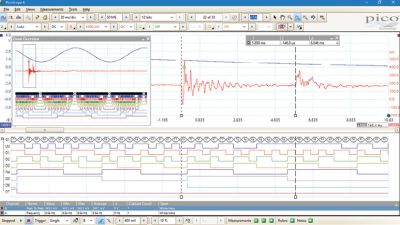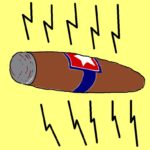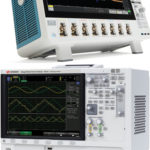It used to be the case that only a few kinds of relatively simple instruments were based on PCs. Now several categories of lab-grade instrumentation take the PC approach.
Trevor Smith, Pico Technology
The diversity of measurements that must be made by electronics engineers constitutes a huge challenge. The debugging and validation of components and systems calls for versatile instruments with wide-ranging functions and easy programmability. Engineers working on high-speed logic one day might be called upon to run a long-duration soak test on the next and check for immunity to power harmonics on the day after that. Such chores require versatile tools that span a broad range of tasks with a minimum of fuss.

The PicoScope 6824E oscilloscope, here connected to host PC, and the scope’s PCB carrying the FPGA that handles much of the work. The availability of high-performance FPGAs is one factor that makes PC-based scopes practical
PC-based test and measurement products address those needs. These instruments utilize industry-standard PC hardware for instrument control, analysis and display of measurement results. Instrument acquisition hardware sits in a compact enclosure that connects to the host PC, typically with a USB 2.0 or 3.0 connection. Connectors for the input and output signals to and from the device under test (DUT) are provided as is a separate power connection, where required.
Hardware design typically centers around advanced FPGA technology that controls the channel settings, signal conditioning, triggering, on-board memory management and communication with the host PC. The FPGA does the heavy-duty processing of test data acquisition and, if required, signal generation. Data flowing on the USB interface is limited to commands, responses and composite information required for processing and display of graphical or numerical test data.
Separating the acquisition hardware from the analysis and display platform provides several advantages. Software typically installs on any Windows 10 machine as well as on Linux and macOS industry-standard platforms, so users have the freedom to choose a desktop machine in the lab or a laptop at home or in the field. Most Pico software packages can take advantage of high-definition and UHD displays for clear presentation of waveforms, measurements and analysis results.
Custom applications are also possible. For example, every Pico PC-based instrument comes with a free software development kit (SDK) that includes a programmer’s guide and code examples in widely used languages such as C#, C++ and Python. The application programming interface exposes the full instrument hardware so programmers can develop their own code to control the instrument.

A screen shot generated by PicoScope 6 user interface software that provides the functions of an oscilloscope, spectrum analyzer, serial protocol analyzer, logic analyzer, function/sweep generator, and arbitrary waveform generator.
It’s possible to find PC-based oscilloscopes featuring real-time bandwidths from 10 MHz to 1 GHz and a choice of two, four or eight analog channels, plus up to 16 digital channels on MSO models. There are flexible- and high-resolution models too, with up to 16 bits for precision analog measurements. Many models have an integrated function generator and arbitrary waveform generator. For example, all PicoScope real-time oscilloscopes come with PicoScope 6 user interface software that delivers six instrument functions: an oscilloscope, spectrum analyzer, serial protocol analyzer (21 serial decoder/analyzers included, with more in development), logic analyzer (on MSO models), function/sweep generator, and an arbitrary waveform generator.
PC-based scopes such as the PicoScope 2000 Series feature a small enclosure that fits easily in a laptop bag. These scopes are well suited for education, sporting bandwidths from 10 to 100 MHz and two channels or 2+16 channels on MSO models. More general-purpose scopes typically provide 200 MHz bandwidths. Examples include the PicoScope 3000 Series with two or four channels plus 16 digital channels on MSO models.
Specific models of PC-based scopes are optimized for subsets of requirements common to test and measurement scenarios. In applications that need precision measurements ranging from a few millivolts to hundreds of volts, high-precision scopes with fixed 12- and 16-bit resolutions are available with over 70 dB dynamic range and differential-inputs. Some versatile scopes can make high-speed timing measurements with 1 nsec resolution at 8-bit vertical resolution or 12/14/15/16-bit vertical resolution at lower sampling rates. Also available are high-performance, deep-memory scopes for demanding signal integrity and other scientific applications. These devices can provide up to 1 GHz bandwidth and 4 GS capture memory for big-data analysis of waveforms.
Even high bandwidths are now available on PC-based scopes. An example is the PicoScope 9000 Series providing bandwidths to 25 GHz. Clock recovery enables characterization of high-speed NRZ/RZ data signals as eye diagrams to reveal jitter, noise, rise time and other important parameters. TDR/TDT functions help characterize high-speed communication channels through cables, connectors, backplanes and PCBs. Models with optical inputs can perform eye diagram measurements with automatic measurement of parameters including extinction ratio, S/N ratio, eye height and eye width.
As with dedicated bench instruments, PC-based instrumentation makers also provide specialized probes for tricky measurements. Examples include the PicoConnect 900 Series low-impedance RF, microwave and gigabit pulse probes allowing fingertip browsing of broadband signals up to 5 GHz (10 GB/sec), A3000 Series active probes to 1.3 GHz bandwidth, and high-voltage differential probes to 7,000 V.

A Network Metrology Training (NMT) kit helps perform VNA calibration and network measurement tasks. Included are N and SMA adapters, calibration standards, test leads and fixed wrenches.
Vector network analyzers also come in the form of PC-based instruments. Examples include the PicoVNA 108 8.5 GHz and PicoVNA 106 6 GHz instruments able measure all four S-parameters at each frequency point in under 190 µsec—thus producing a 201-point two-port .s2p Touchstone file in less than 38 msec. The PicoVNA 108 delivers a dynamic range of 124 dB at 10 Hz (118 dB for the PicoVNA 106) and less than 0.006 dB RMS trace noise at its maximum operating bandwidth of 140 kHz. These instruments can also work as deep-dynamic-range scalar network analyzers or single-port vector reflectometers as well as full-function dual-port, dual-path VNAs.
Economical check standards can be used to validate the accuracy of a network analysis test setups and calibration before and after measurements. Akin to the Beatty line, each check standard is a short length of mismatched line (75 mm of 25 Ω) with a predictable, smooth and stable mismatch and transmission characteristic that spans the VNA frequency range.
Data acquisition
Another category of PC-based products is that for data logging. Data loggers require no power supply and simply plug into a USB or an Ethernet port on a PC or network. Data acquisition software handles measurements, recording, and data analysis. Moreover, data acquisition software,

such as PicoLog 6, works with all PicoScope real-time oscilloscopes as well as with acquisition products. Examples of these include the TC-08 eight-channel thermocouple data logger. It can measure from –270 to 1,820°C (–454 to 3,308°F) with high resolution and accuracy and is expandable to 20 units/ 160 channels. Another device called the PT-104 platinum resistance temperature data logger measures temperatures ranging from –200 to 800°C with either PT100 or PT1000 sensors. It uses high-precision reference resistors for high stability and realizes up to 0.001°C resolution and 0.015°C accuracy.
High-resolution data loggers such as the ADC-20 and ADC-24 detect small signal changes precision voltage data loggers deliver 20 and 24-bit resolution respectively. Features such as true differential inputs, galvanic isolation and software-selectable sampling rates all contribute to noise-free resolution.
Multi-purpose data loggers are also available, typically with a choice of 10 or 12-bit input resolution. And there are special-purpose data loggers. An example is the PicoLog CM3 which is designed for measuring the current consumption of buildings and machinery and, in that regard, is suitable for single or three-phase ac.





